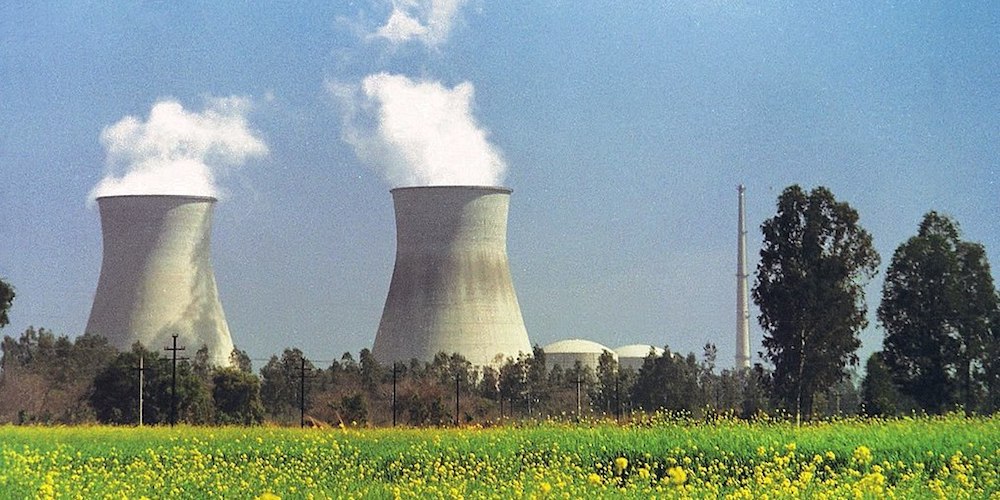India to boost its nuclear capacity

The Government has embarked on a large nuclear power capacity addition programme to increase the share of nuclear power in electricity generation.
According to Union Minister of State (Independent Charge) Science & Technology; Minister of State (Independent Charge) Earth Sciences; MoS PMO, Personnel, Public Grievances, Pensions, Atomic Energy and Space, Dr Jitendra Singh, more nuclear power plants are also planned in future and the nuclear power capacity is expected to reach 22480 MW by the year 2031 from the current 6780 MW.
Dr Singh has revealed that the share of nuclear power in the total electricity generation in the country is about 3.1% in the year 2020-21. Obviously, this share has to go up significantly.
There are presently 22 reactors with a total capacity of 6780 MW in operation and one reactor, KAPP-3 (700 MW) has been connected to the grid on January 10, 2021. Ten (10) nuclear power reactors with 8000 MW capacity (including 500 MW PFBR being implemented by Bharatiya Nabhikiya Vidyut Nigam Limited {BHAVINI}) are under construction.
Additionally, the Government has accorded administrative approval and financial sanction of ten (10) indigenous Pressurized Heavy Water Reactors (PHWRs) of 700 MW each to be set up in fleet mode.
It may be noted that India has five electricity grids – Northern, Eastern, North-Eastern, Southern and Western. All of them are interconnected to some extent, except the Southern grid. All are run by the state-owned Power Grid Corporation of India Ltd (PGCI), which operates more than 95,000 circuit km of transmission lines.
Nuclear power is the fifth-largest source of electricity in India after coal, gas, hydroelectricity and wind power.
In October 2010, India had drawn up a plan to reach a nuclear power capacity of 63 GW in 2032. However, following the 2011 Fukushima nuclear disaster in Japan, there have been numerous anti-nuclear protests at proposed nuclear power plant sites. There have been mass protests against the Jaitapur Nuclear Power Project in Maharashtra and the Kudankulam Nuclear Power Plant in Tamil Nadu, and a proposed large nuclear power plant near Haripur was refused permission by the Government of West Bengal. A Public Interest Litigation (PIL) has also been filed against the government’s civil nuclear programme at the Supreme Court.
But there are innumerable studies that say that the aforesaid apprehensions are highly exaggerated. Nuclear power is as safe or as risky as any other power. And what is more important, it is environment-friendly.
For a large country like India, a major fraction of energy must come from domestic resources. From a long-term perspective, we have rather limited options in this regard. There are environmental issues, which will be inevitably associated with large-scale deployment of coal. Apart from this, a fact, which is often overlooked, is that the existing reserves of coal in India would be inadequate to meet an enhanced rate of energy consumption, comparable to today’s world average per capita level-as needed for an improved quality of life for its entire population, for more than a few decades.
Solar and other renewable, and non-conventional energy sources must be deployed to the fullest extent possible. However, to meet the large concentrated energy needs for industries and urban centers, the only sustainable energy resource available to us in India, indeed the entire world in a longer-term time frame, is nuclear energy.
Here too, we are in a rather unique situation with regard to the availability of nuclear resources in our country. We have rather meagre reserves of uranium, the only naturally occurring fissile element that can be directly used in a nuclear reactor to produce energy through nuclear fission.
We, however, have nearly a third of the entire world’s thorium, which is a fertile element, and needs to be first converted to a fissile material, uranium-233, in a reactor. Our strategies for large scale deployment of nuclear energy must be, and are therefore, focussed towards utilisation of thorium.
Keeping this in view, India has had a THREE-STAGE INDIAN NUCLEAR POWER PROGRAMME.
The importance of nuclear energy, as a sustainable energy resource for our country, was recognised at the very inception of our atomic energy programme more than four decades ago. A three-stage nuclear power programme, based on a closed nuclear fuel cycle, was then chalked out. The three stages are:
1 – Natural uranium fuelled Pressurised Heavy Water Reactors (PHWRs)
2 – Fast Breeder Reactors (FBRs) utilising plutonium based fuel
3 – Advanced nuclear power systems for utilisation of thorium.
It may be noted that India has been making advances in the field of thorium-based fuels, working to design and develop a prototype for an atomic reactor using thorium and low-enriched uranium.



